A Bluetooth/PDR Integration Algorithm for an Indoor Positioning System
Abstract
:1. Introduction
2. Beacon-Based Point Positioning
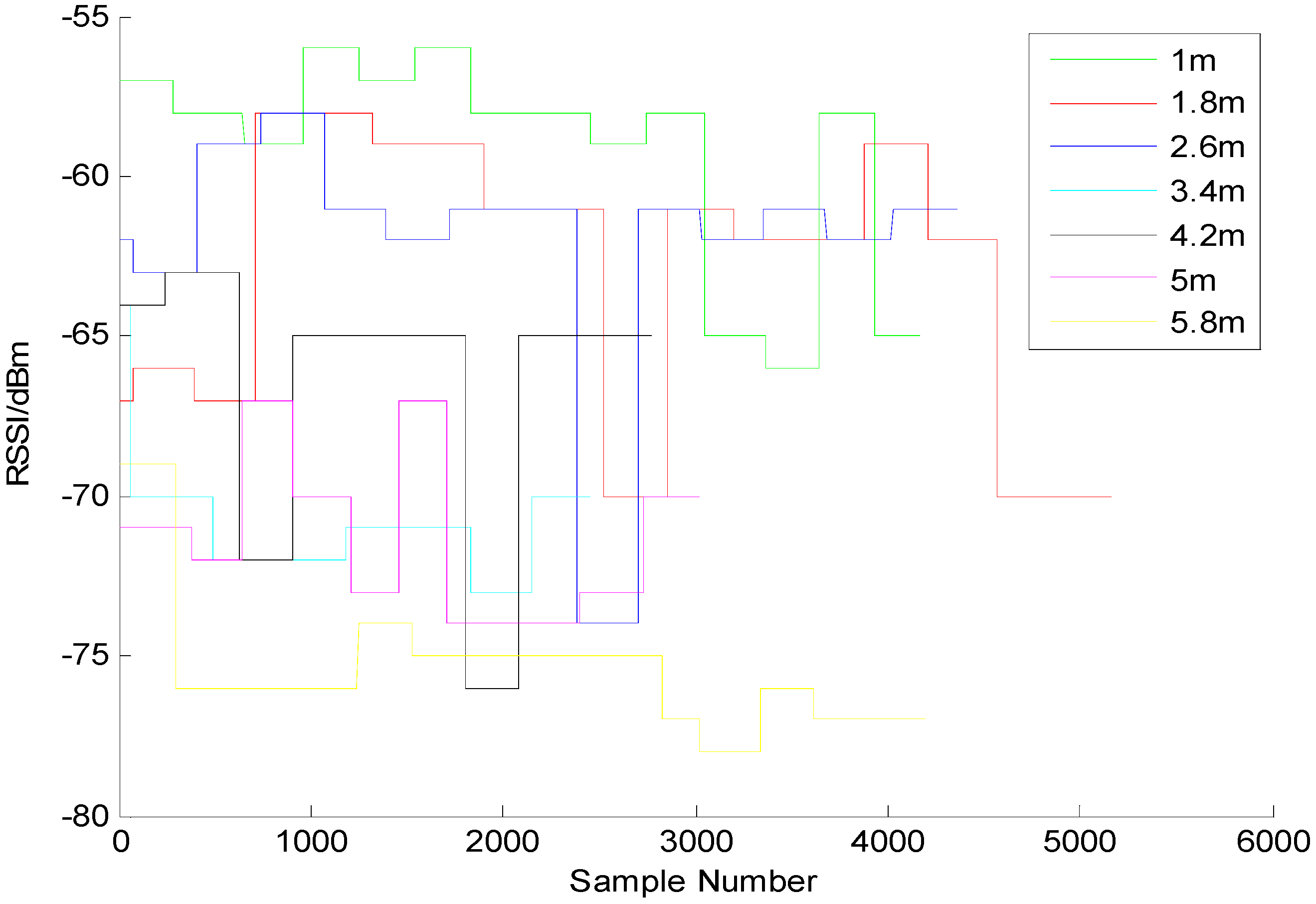
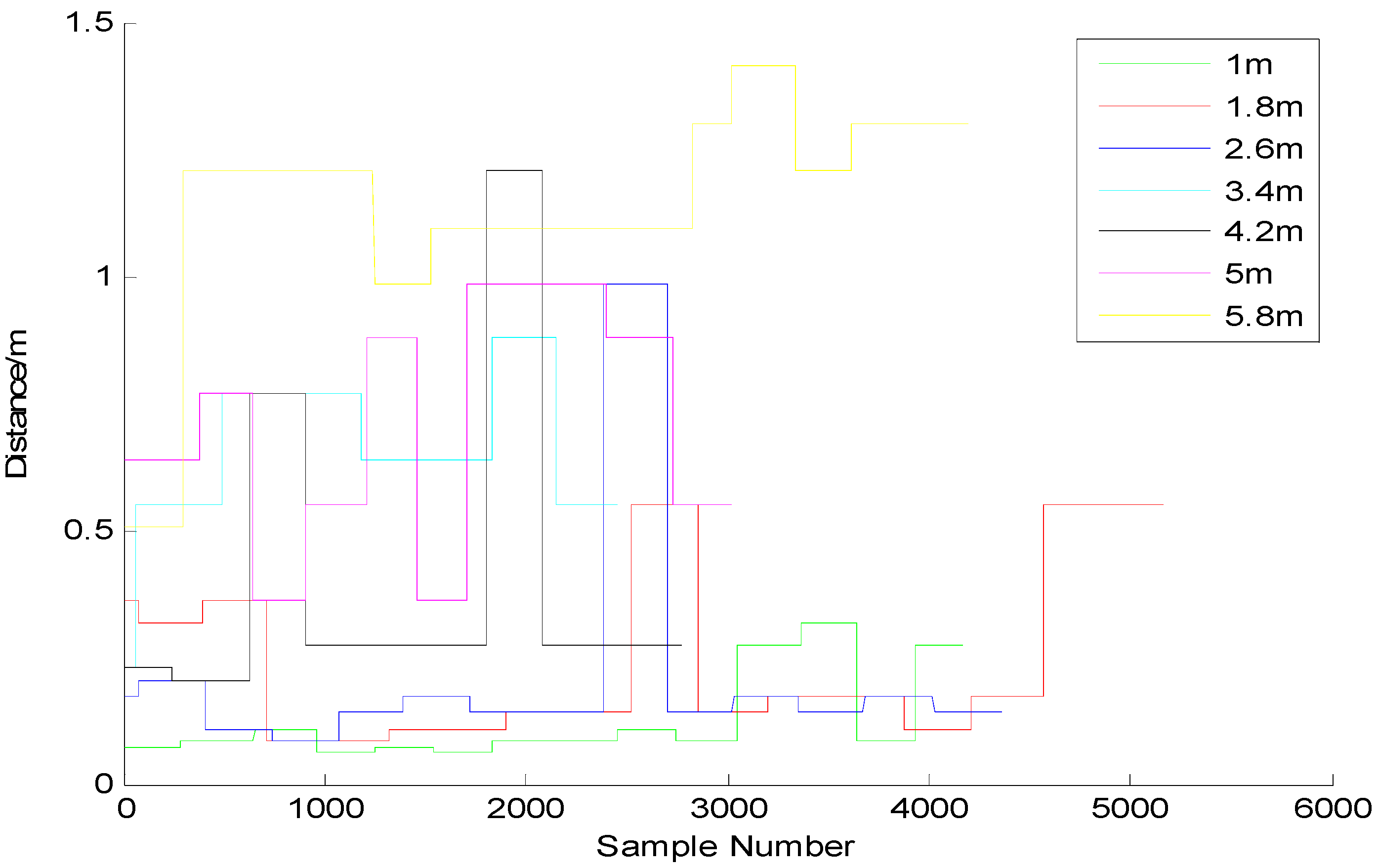
3. PDR Algorithm Based on the Inertial Sensor in Mobile Phones
3.1. Multi-Threshold Step Detection
- (1)
- and representing separately the amplitude at the extreme point of the peak and valley on the waveform.
- (2)
- and representing separately the amplitude difference between the adjacent peaks and between the adjacent valleys.
- (3)
- and representing separately the time difference between two adjacent peaks and between two adjacent valleys.
- (4)
- and representing separately the time difference between the adjacent peak and valley or between the adjacent valley and peak.

| Within 5% | Absolutely Accurate | Greater than 5% | |
|---|---|---|---|
| walk1 | 0.04~0.12 | 0.13~0.36 | <0.04 or >0.36 |
| walk2 | 0.03~0.10 | 0.11~0.28 | <0.03 or >0.28 |
| run1 | 0.03~0.13 or 0.16~0.24 | 0.14~0.15 | <0.03 or >0.24 |
| run2 | 0.13~0.15 | 0.14 | <0.13 or >0.15 |

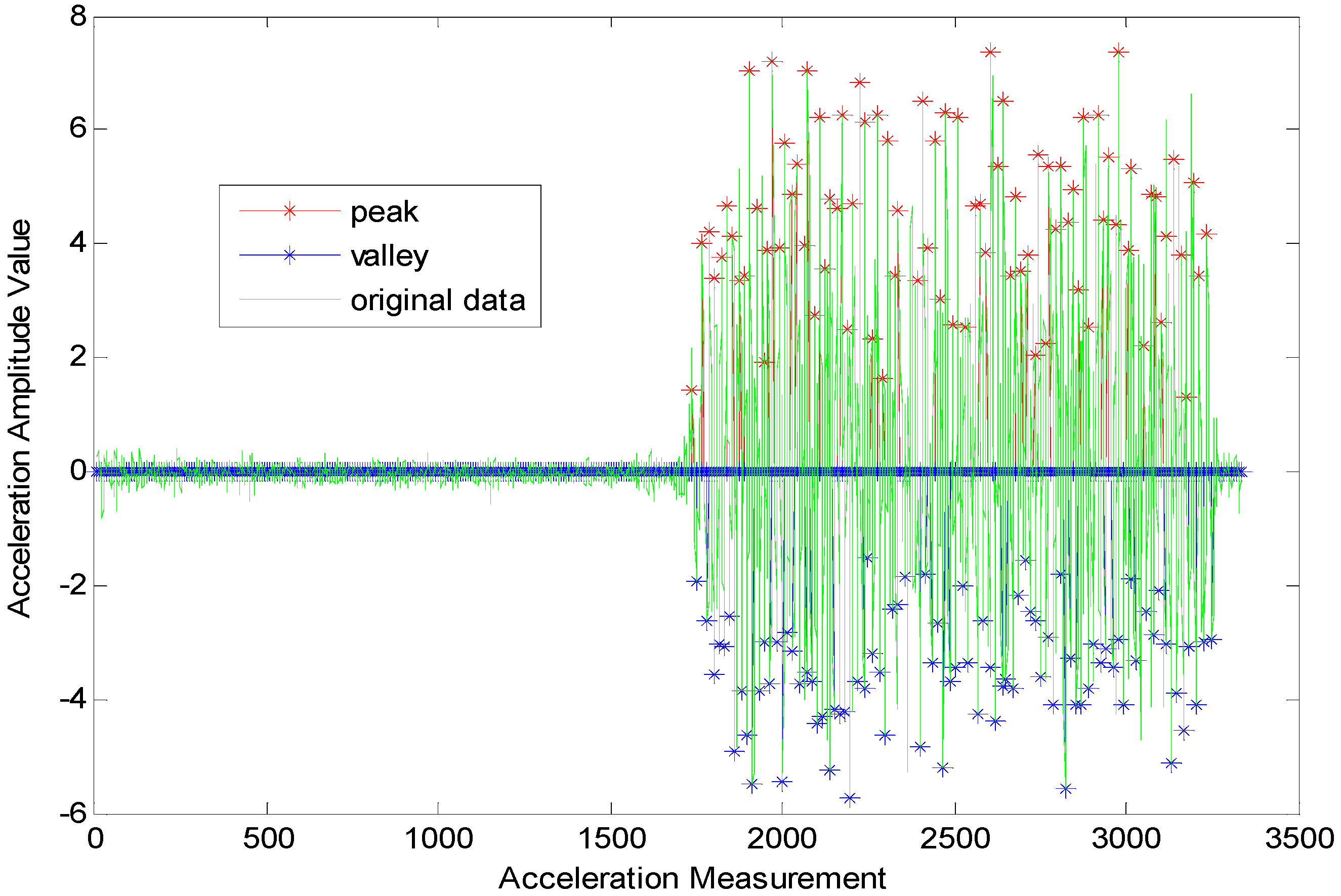
3.2. Step Length Estimation
| Real Distance | |||||||
|---|---|---|---|---|---|---|---|
| 40.5 | 71.4 | 43.2 | 39.5 | 81.6 | 211.68 | 179 | |
| Linear model (Equation (6)) SLM1 | 38.608 | 73.766 | 43.348 | 40.421 | 81.526 | 213.771 | 182.391 |
| Distance difference ΔSLM1 | −1.892 | 2.366 | 0.148 | 0.921 | −0.074 | 2.091 | 3.391 |
| Linear model (Equation (7)) SLM2 | 41.411 | 71.372 | 44.799 | 38.894 | 82.381 | 209.381 | 178.707 |
| Distance difference ΔSLM2 | 0.911 | −0.028 | 1.599 | −0.606 | 0.781 | −2.299 | −0.293 |
| Non-linear model (Equation (8)) SNLM | 38.427 | 73.065 | 46.227 | 39.895 | 81.520 | 215.612 | 175.950 |
| Distance difference ΔSNLM | −2.073 | 1.665 | 3.027 | 0.395 | −0.080 | 3.932 | −3.050 |
3.3. Heading Estimation with Real-Time Compensation Based on Kalman Filter
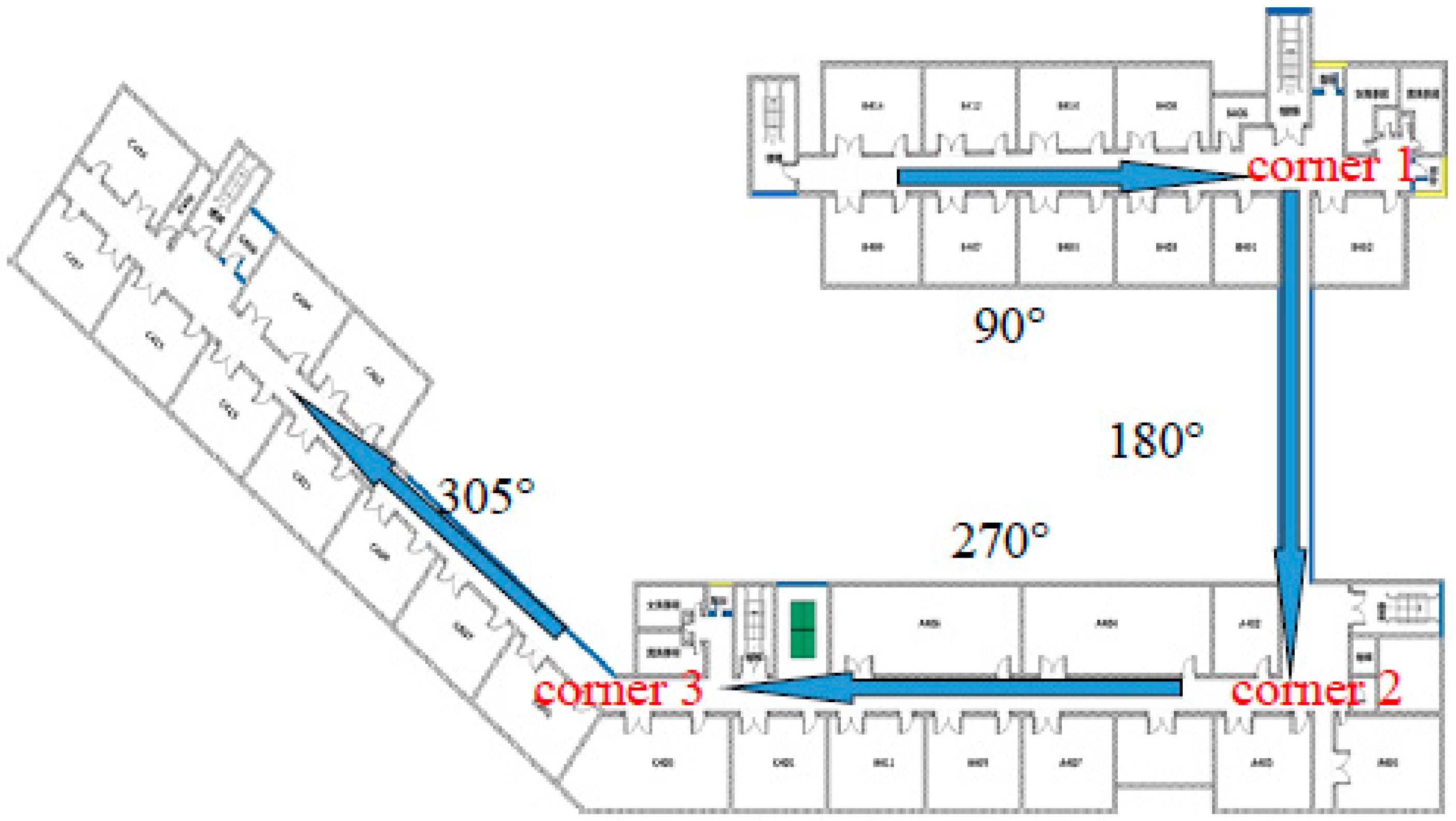
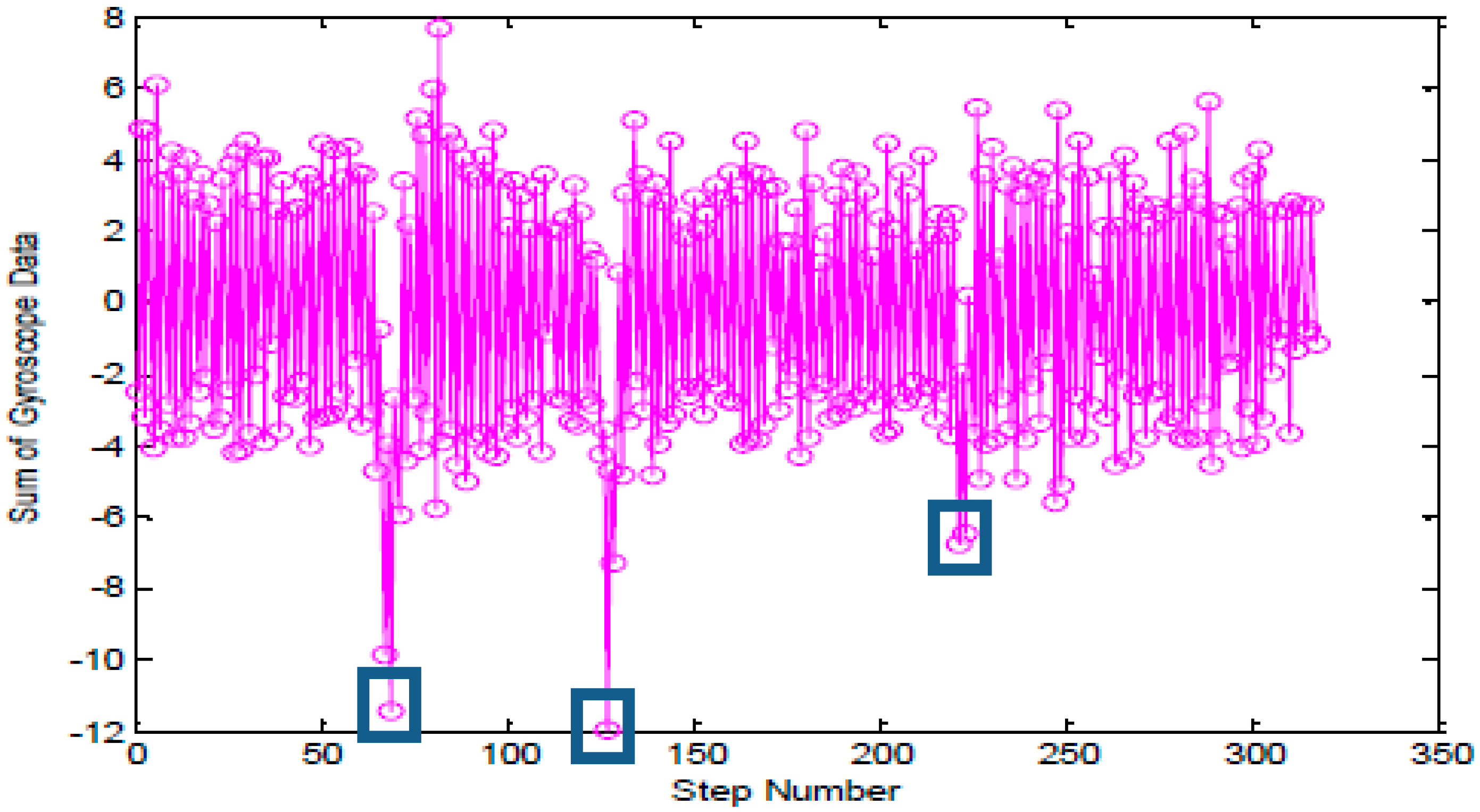
| The Real Azimuth of 90° | The Real Azimuth of 180° | The Real Azimuth of 270° | The Real Azimuth of 305° | |||||
|---|---|---|---|---|---|---|---|---|
| Initial Azimuth | Our Approach | Initial Azimuth | Our Approach | Initial Azimuth | Our Approach | Initial Azimuth | Our Approach | |
| Mean difference | 17.92 | 6.20 | 5.84 | 1.62 | 16.17 | 2.28 | 10.99 | 5.06 |
| Maximum difference | 28.63 | 15.81 | 12.09 | 4.06 | 22.72 | 17.52 | 20.54 | 18.18 |
| Minimum difference | 10.02 | 0.35 | 0.34 | 0.19 | 8.02 | 0.05 | 0.74 | 0.18 |
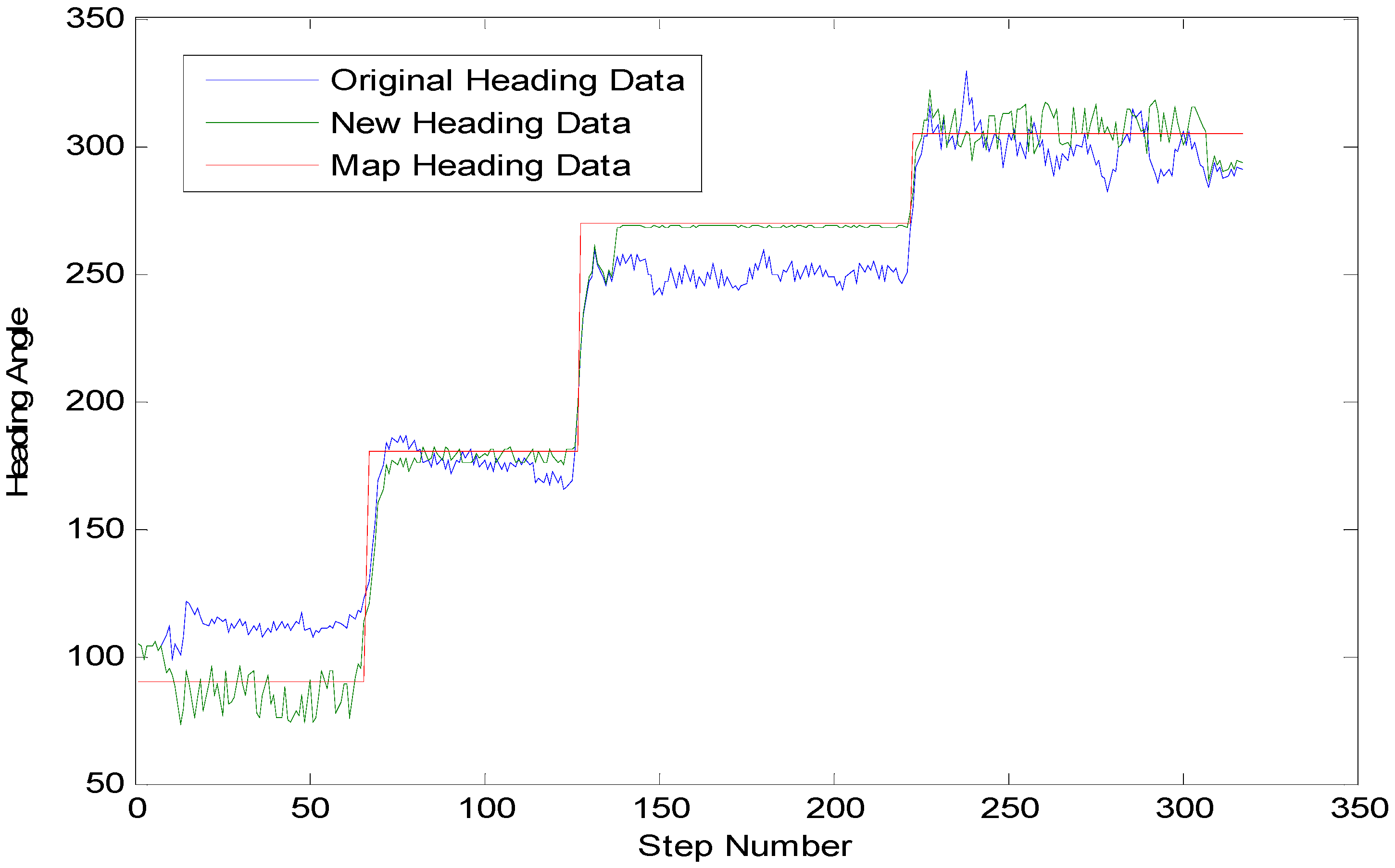
4. Positioning Integrated with Bluetooth and PDR
4.1. PDR Positioning Based on Map Matching and Bluetooth-Based Position Correction
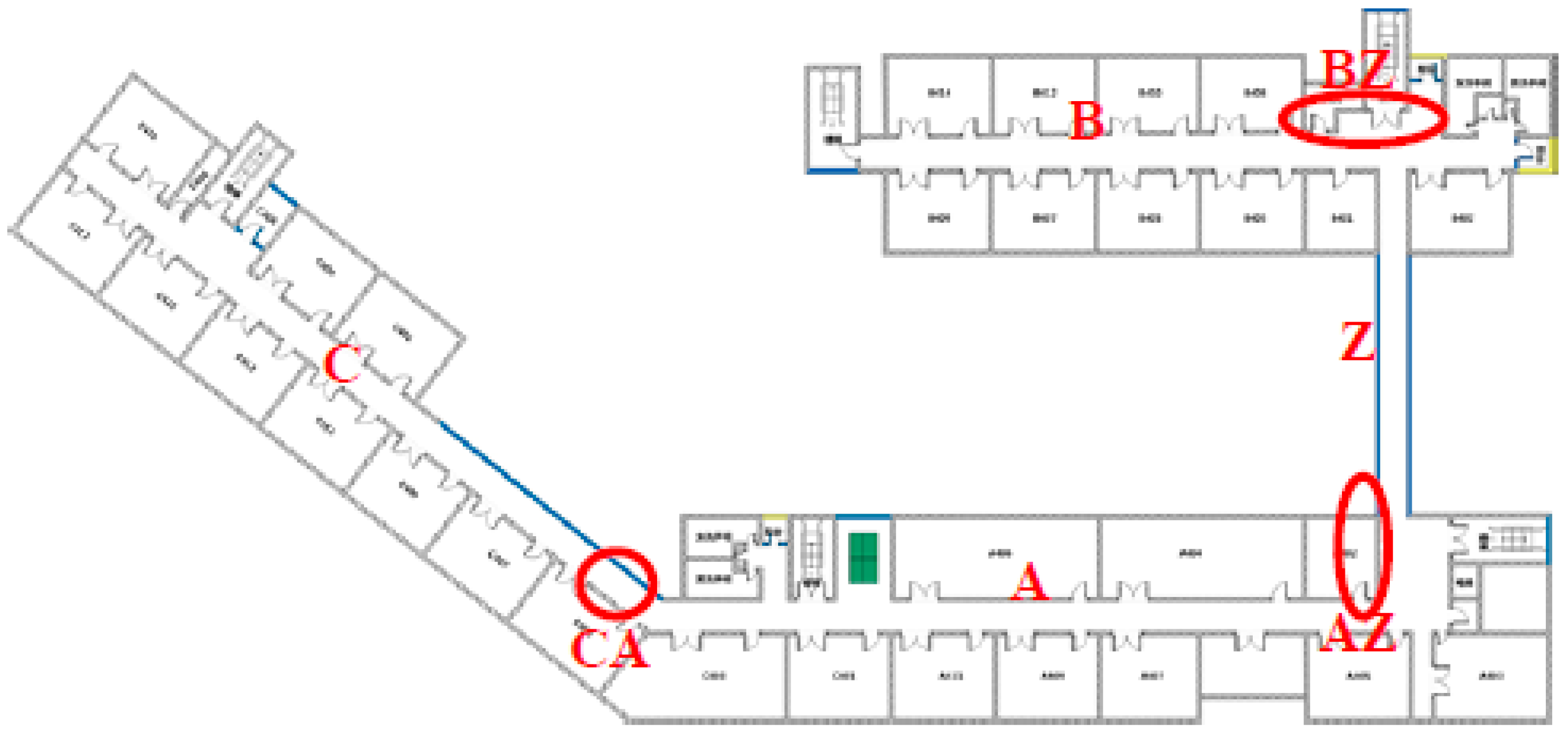
4.2. Fusion Positioning Based on Adaptive Noise Extended Kalman Filter
5. Experimental Section

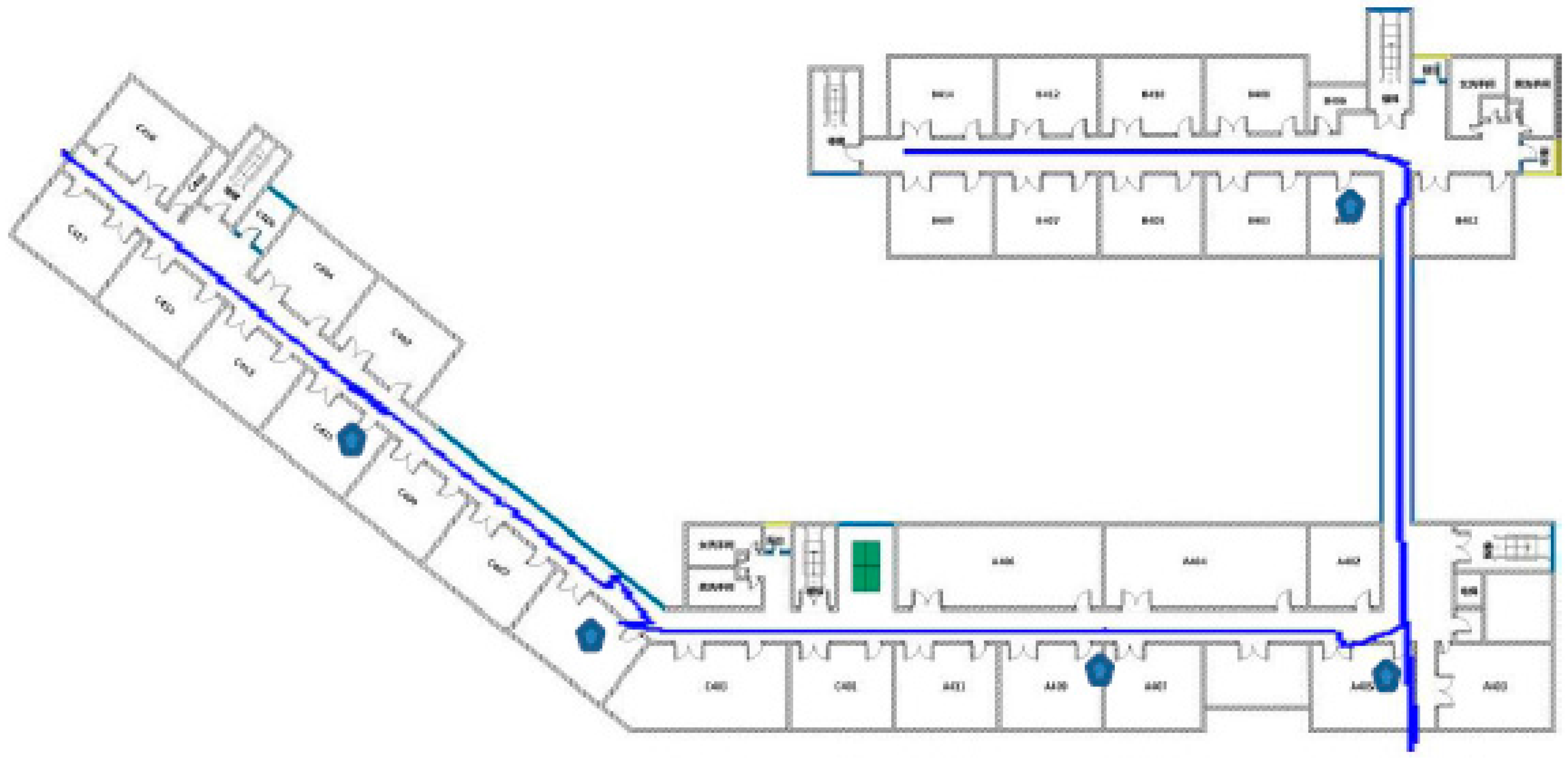
| OHPDR | AHPDR | BEPDR | EKFPDR | |
|---|---|---|---|---|
| Min. error/m | 2.00 | 2.00 | 0.34 | 0.25 |
| Mean error/m | 22.67 | 5.42 | 4.12 | 2.26 |
| Max. error/m | 44.85 | 6.79 | 12.21 | 5.09 |

| Beacons | 10 | 15 | 20 |
|---|---|---|---|
| Min. error/m | 0.41 | 0.36 | 0.25 |
| Mean error/m | 3.97 | 3.15 | 2.26 |
| Max. error/m | 5.95 | 5.42 | 5.09 |
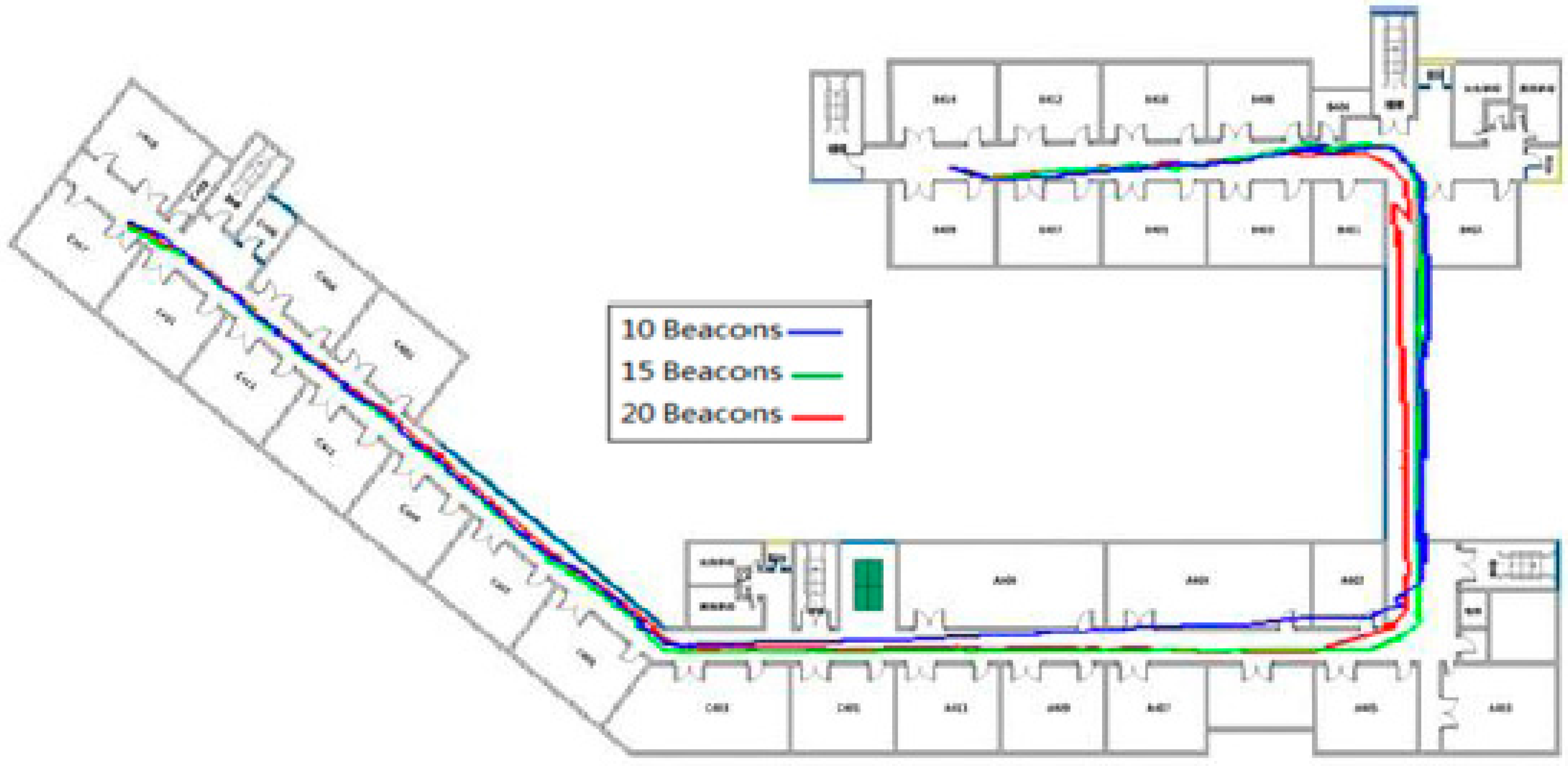
6. Conclusions
Acknowledgments
Author Contributions
Conflicts of Interest
References
- Mautz, R. Indoor Positioning Technologies. Ph.D. Thesis, ETH Zürich, Zürich, Switzerland, 2012. [Google Scholar]
- Gu, Y.; Lo, A.; Niemegeers, I. A survey of indoor positioning systems for wireless personal networks. IEEE Commun. Surv. Tutor. 2009, 11, 13–32. [Google Scholar] [CrossRef]
- Hightower, J.; Borriello, G. Location systems for ubiquitous computing. Computer 2001, 34, 57–66. [Google Scholar] [CrossRef]
- Harle, R. A survey of indoor inertial positioning systems for pedestrians. Commun. Surveys Tuts. 2013, 15, 1281–1293. [Google Scholar] [CrossRef]
- Pahlavan, K.; Li, X.; Makela, J.-P. Indoor geolocation science and technology. IEEE Commun. Mag. 2002, 40, 112–118. [Google Scholar] [CrossRef]
- Jimenez, A.; Seco, F.; Prieto, C.; Guevara, J. A comparison of pedestrian dead-reckoning algorithms using a low-cost MEMS IMU. In Proceedings of the IEEE International Symposium on Intelligent Signal Processing, Budapest, Hungary, 26–28 August 2009; pp. 37–42.
- Mautz, R. The challenges of indoor environments and specification on some alternative positioning systems. In Proceedings of the 6th Workshop on Positioning, Navigation and Communication, Hannover, Germany, 19 March 2009; pp. 29–36.
- Miller, L.E. Indoor Navigation for First Responders: a Feasibility Study; Citeseer: Gaithersburg, MD, USA, 2006. [Google Scholar]
- Foxlin, E. Pedestrian tracking with shoe-mounted inertial sensors. IEEE Comput. Gr. Appl. 2005, 25, 38–46. [Google Scholar] [CrossRef]
- Feliz Alonso, R.; Zalama Casanova, E.; Gómez García-Bermejo, J. Pedestrian tracking using inertial sensors. J. Phys. Agent. 2009, 3, 35–43. [Google Scholar]
- Jiménez, A.R.; Seco, F.; Prieto, J.C.; Guevara, J. Indoor Pedestrian Navigation using an INS/EKF framework for Yaw Drift Reduction and a Foot-mounted IMU. In Proceedings of the 7th Workshop on Positioning Navigation and Communication (WPNC), Dresden, Germany, 11–12 March 2010; pp. 135–143.
- Ruiz, A.R.J.; Granja, F.S.; Prieto Honorato, J.C.; Rosas, J.I.G. Accurate pedestrian indoor navigation by tightly coupling foot-mounted IMU and RFID measurements. IEEE Instrum. Meas. Transac. 2012, 61, 178–189. [Google Scholar] [CrossRef]
- Adams, D. Introduction to inertial navigation. J. Navig. 1956, 9, 249–259. [Google Scholar] [CrossRef]
- Jiménez, A.R.; Zampella, F.; Seco, F. Improving inertial pedestrian dead-reckoning by detecting unmodified switched-on lamps in buildings. Sensors 2014, 14, 731–769. [Google Scholar] [CrossRef] [PubMed]
- Yim, J. Introducing a decision tree-based indoor positioning technique. Expert Syst. Appl 2008, 34, 1296–1302. [Google Scholar] [CrossRef]
- Afzal, M.H.; Renaudin, V.; Lachapelle, G. Assessment of indoor magnetic field anomalies using multiple magnetometers. In Proceedings of 23rd International Technical Meeting of the Satellite Division of the Institute of Navigation, Portland, OR, USA, 21–24 September 2010; pp. 1–9.
- Wang, J.; Hu, A.; Liu, C.; Li, X. A Floor-Map-Aided WiFi/Pseudo-Odometry Integration Algorithm for an Indoor Positioning System. Sensors 2015, 15, 7096–7124. [Google Scholar] [CrossRef] [PubMed]
- Piras, M.; Lingua, A.; Dabove, P.; Aicardi, I. Indoor Navigation Using Smartphone Technology: A Future Challenge Or An Actual Possibility? In Proceedings of the 2014 IEEE/ION Position, Location and Navigation Symposium, Monterey, CA, USA, 5–8 May 2014; pp. 1343–1352.
- Aicardi, I.; Corbi, C.; Lingua, A.M.; Lepsoy, S.; Francini, G.; Aicardi, I.; Corbi, C. The MPEG7 Visual Search Solution for image recognition based positioning using 3D models. In Proceedings of the 2014 ION GNSS+, Tampa, FL, USA, 15–18 September 2014.
- Gusenbauer, D.; Isert, C.; Krösche, J. In Self-contained indoor positioning on off-the-shelf mobile devices. In Proceedings of the Indoor Positioning and Indoor Navigation, Zurich, Switzerland, 15–17 September 2010; pp. 1–9.
- Kourogi, M.; Kurata, T. Personal positioning based on walking locomotion analysis with self-contained sensors and a wearable camera. In Proceedings of the 2nd IEEE/ACM International Symposium on Mixed and Augmented Reality, Washington, DC, USA, 7–10 October 2003; pp. 103–110.
- Using the ADXL202 in pedometer and personal navigation applications. Available online: http://www.analog.com/media/en/technical-documentation/application-notes/ (accessed on 10 July 2015).
- Chen, W.; Chen, R.; Chen, X. Comparison of EMG-based and Accelerometer-based Speed Estimation Methods in Pedestrian Dead Reckoning. J. Navig. 2011, 64, 265–280. [Google Scholar] [CrossRef]
- Vildjiounaite, E.; Malm, E.-J.; Kaartinen, J.; Alahuhta, P. Location Estimation Indoors by Means of Small Computing Power Devices, Accelerometers, Magnetic Sensors, and Map Knowledge. In Pervasive Computing; Springer: Berlin, Germany, 2002; pp. 211–224. [Google Scholar]
- Cho, S.Y.; Park, C.G. MEMS Based Pedestrian Navigation System. J. Navig. 2006, 59, 135–153. [Google Scholar] [CrossRef]
- Klingbeil, L.; Wark, T. A wireless sensor network for real-time indoor localisation and motion monitoring. In Proceedings of the 2008 International Conference on Information Processing in Sensor Networks (IPSN’08), Washington, DC, USA, 22–24 April 2008; pp. 39–50.
- Xiao, W.; Ni, W.; Toh, Y.K. Integrated Wi-Fi fingerprinting and inertial sensing for indoor positioning. In Proceedings of the 2011 International Conference on Indoor Positioning and Indoor Navigation (IPIN), Guimarães, Portugal, 21–23 September 2011; pp. 1–6.
- Afzal, M.H.; Renaudin, V.; Lachapelle, G. Magnetic field based heading estimation for pedestrian navigation environments. In Proceedings of the 2011 International Conference on Indoor Positioning and Indoor Navigation (IPIN), Guimaraes, Portugal, 21–23 September 2011; pp. 1–10.
- Thomson, C. Factors effecting positional accuracy of Beacons. In Presented at R08 Associate Lecturer Scholarship Showcase, Manchester, UK, 29 March 2014.
- Li, F.; Zhao, C.; Ding, G.; Gong, J.; Liu, C.; Zhao, F. A reliable and accurate indoor localization method using phone inertial sensors. In Proceedings of the 2012 ACM Conference on Ubiquitous Computing, Pittsburgh, PA, USA, 5–8 September 2012; pp. 421–430.
- Levi, R.W.; Judd, T. Dead Reckoning Navigational System Using Accelerometer to Measure Foot Impacts. U.S. Patent 5,583,776, 10 December 1996. [Google Scholar]
- Ladetto, Q. On foot navigation: continuous step calibration using both complementary recursive prediction and adaptive Kalman filtering. In Proceedings of the 13th International Technical Meeting of the Satellite Division of The Institute of Navigation (ION GPS), Salt Lake City, UT, USA, 19–22 September 2000; pp. 1735–1740.
- Woodman, O.; Harle, R. Pedestrian localisation for indoor environments. In Proceedings of the 10th International Conference on Ubiquitous Computing, Seoul, Korea, 21–24 September 2008; pp. 114–123.
- Krach, B.; Roberston, P. Cascaded estimation architecture for integration of foot-mounted inertial sensors. In Proceedings of the 2008 IEEE/ION Position, Location and Navigation Symposium, Monterey, CA, USA, 6–8 May 2008; pp. 112–119.
- Kang, W.; Nam, S.; Han, Y.; Lee, S. Improved heading estimation for smart phone-based indoor positioning systems. In Proceedings of the 2012 IEEE 23rd International Symposium on Personal Indoor and Mobile Radio Communications (PIMRC), Sydney, Australia, 9–12 September 2012; pp. 2449–2453.
- Youssef, M. HORUS: A WLAN-Based Indoor Location Determination System. Ph.D. Thesis, University of Maryland, College Park, MD, USA, 2004. [Google Scholar]
© 2015 by the authors; licensee MDPI, Basel, Switzerland. This article is an open access article distributed under the terms and conditions of the Creative Commons Attribution license (http://creativecommons.org/licenses/by/4.0/).
Share and Cite
Li, X.; Wang, J.; Liu, C. A Bluetooth/PDR Integration Algorithm for an Indoor Positioning System. Sensors 2015, 15, 24862-24885. https://doi.org/10.3390/s151024862
Li X, Wang J, Liu C. A Bluetooth/PDR Integration Algorithm for an Indoor Positioning System. Sensors. 2015; 15(10):24862-24885. https://doi.org/10.3390/s151024862
Chicago/Turabian StyleLi, Xin, Jian Wang, and Chunyan Liu. 2015. "A Bluetooth/PDR Integration Algorithm for an Indoor Positioning System" Sensors 15, no. 10: 24862-24885. https://doi.org/10.3390/s151024862






